Post by glactus on Feb 17, 2008 6:20:04 GMT
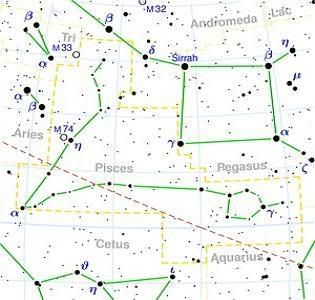

The constellation of Pisces is an autumnal zodiac positioned at next to Aquarius. The constellation is depicted as two fishes connected their tails at alpha Picium, "Al Rischa" meaning - a knot. It's rather faint, and is hard to follow the series of dimmed stars. The sun crosses the celestial equator just around the tail of the western fish; in fact the vernal equinox is included in Pisces now. The vernal equinox is established as the right ascension of zero, and Pisces must be the first zodiac. But in the times of ancient Babylonia, the vernal equinox was lied in east neighbored Aries, so Pisces is registered as the last zodiac in astrology even now.
Notable stars:
Alpha Piscium
Alrescha - Alpha Piscium, The Brightest Star In the Constellation of Pisces. Alrescha is located about 139 light years away. It is a birany system,The primary has a magnitude of 4.3 and the companion is 5.2 magnitude. The period is 720 years.
Beta Piscium
Beta Pisces is a blue class B5 star. It also has the traditional name Fum al Samakah, Arab for "muzzle of the fish" The star belongs to the spectral class B6Ve, is of magnitude 4.53 and approximately 492 light-years from the Sun.
Gamma
Gamma Pisces is a 3.6 magnitude yellow class G8 star. It is a yellow giant about 130 light years from Earth. Observation of its motion across the sky reveals it to be moving to the east at over three-quarters of a second of arc per year, which at 130 light years corresponds to 145 kilometers per second, over 7 times faster than most local stars. Its speed reveals that Gamma Piscium is a visitor from a another part of the Galaxy.
54 Piscium
54 Piscium is an orange-red main-sequence dwarf star of spectral and luminosity type K0+ V, is of 79 percent of Sol's mass, and lies in the northwestern corner of the constellation. On January 16, 2003, astronomers announced the discovery of a Saturn-sized, planetary companion to this star. Magnitude is 5.8 and distance from Earth is 36.2 light years.
Notable objects:
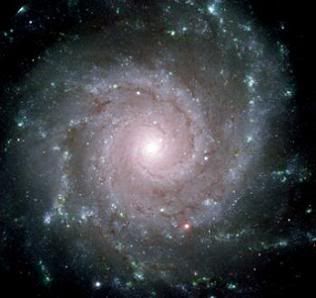
Messier M 74
M74 (NGC628) is the only Messier's object in this constellation. You can find it at about 1 degree east of eta Piscium. It's a very faint spiral galaxy being face on, one of the faintest in Messier's catalogue. It's fairly difficult work to recognize the galaxy with a medium-sized telescope unless you have extremely good-conditioned night. The galaxy is 31.6 million light years away, with magnitude of 10.1
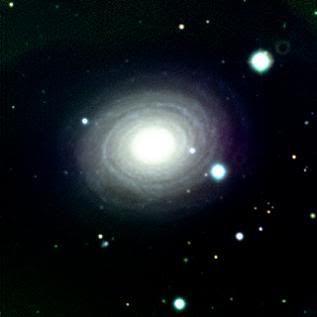
NGC448
At an estimated distance of 90 million light years away NGC 488 is an intriguing galaxy despite its distance from us. This galaxy displays subtle and tightly wound blue spiral arms with a yellowish core. Astronomers that have recently observed this galaxy note that the stars in the disk are orbiting the galaxy at a break-neck speed of 360km/s. Our star is orbiting the Milky Way at 220 km/s, much slower. By studying the velocity distribution of stars in a galaxy like NGC 488, astronomers attempt to answer fundamental questions concerning the structure of these spirals. Magnitude is 10.8.
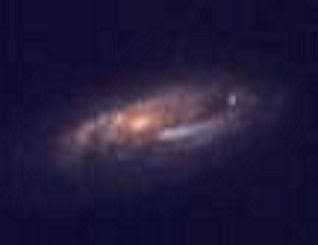
NGC 7541
An Sc spiral located near the western "fish head"
NGC 7541 has a strong asymmetry along the two major semi-axes, thin asymmetric arms and a compact bulge. Astronomers have reported a strong radio source in the spiral arm that contains the supernova in the image above. The red shift gives a distance estimated at 140 million light years. Magnitude is 12.6.
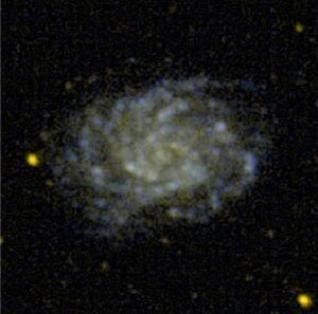
NGC 514
NGC 514 is an intermediate Sc spiral galaxy approximately 100 million light-years from the Milky Way, and has a H II nucleus. The galaxy has difuse spiral arms that are not of the usual pattern, and the blueness of the image depicts feverish starbirth. Magnitude is 12.2.
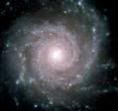
Messier M74
credits:
Pisces map: Wikipdia
en.wikipedia.org/wiki/Pisces_(constellation)
Pisces sun map: Wingmakers
home.xtra.co.nz/hosts/Wingmakers/Pisces.html
image: Messier M74: NASA/ESA/GMOS/HST.
en.wikipedia.org/wiki/Spiral_Galaxy_M74
image: NGC 488: umontreal
ftp.astro.umontreal.ca/~opiomm/images/ngc488/ngc488.jpg
image: NGC 7541: Rochester astronomy
www.rochesterastronomy.org/snimages/sn1998dh.html
image: NGC 514: GALEX/NASA.
en.wikipedia.org/wiki/NGC_514


